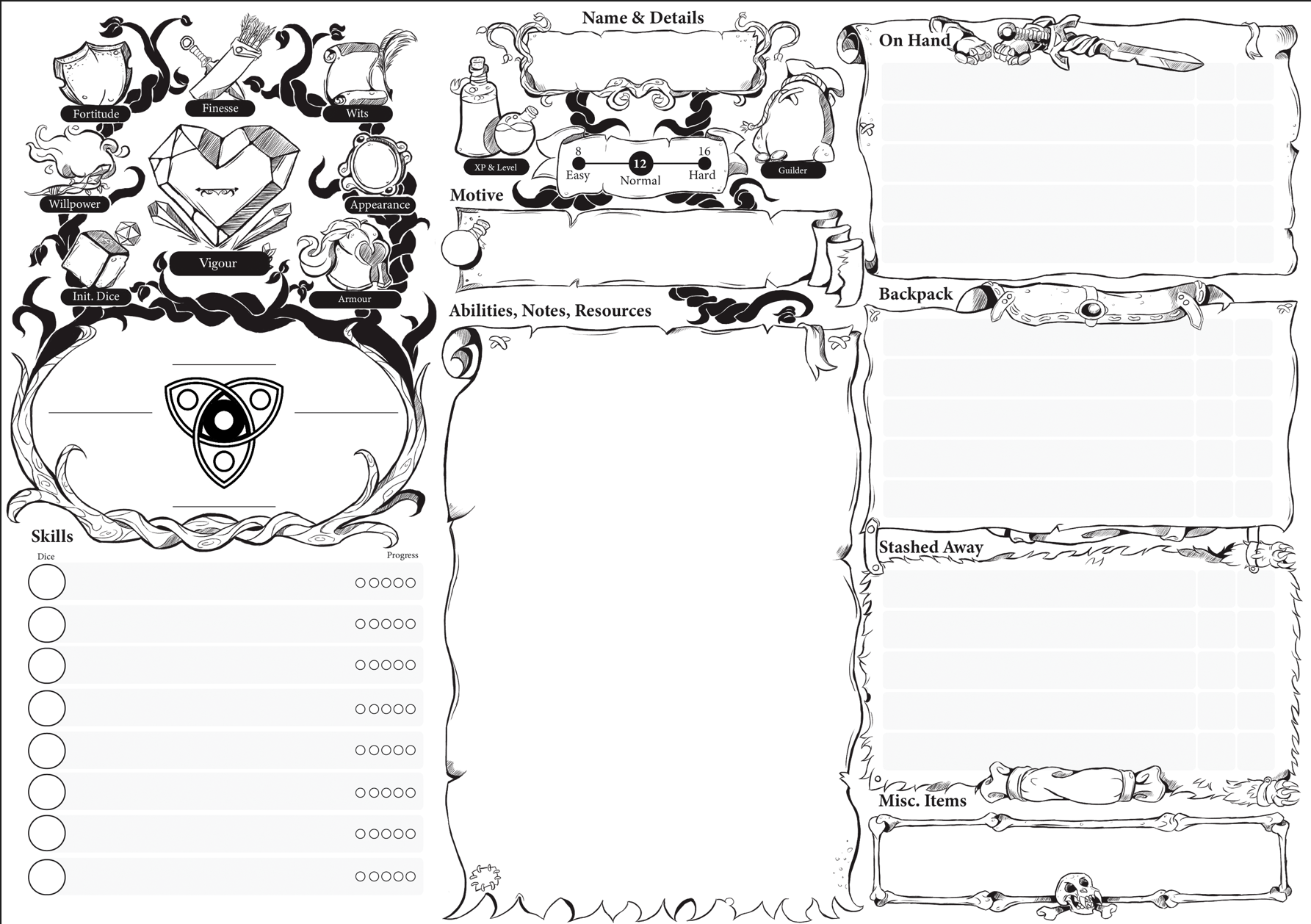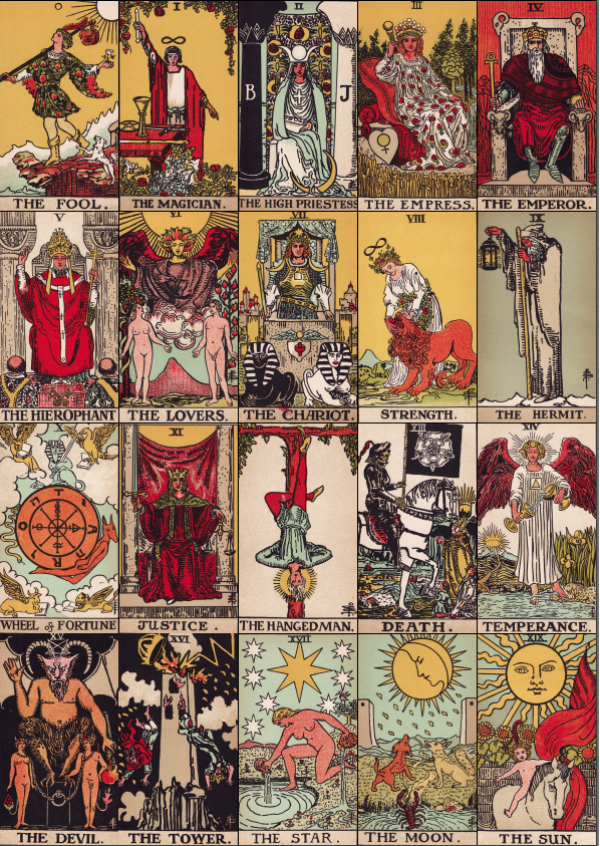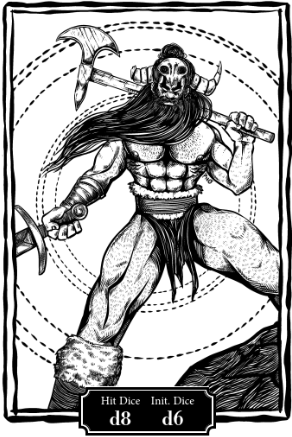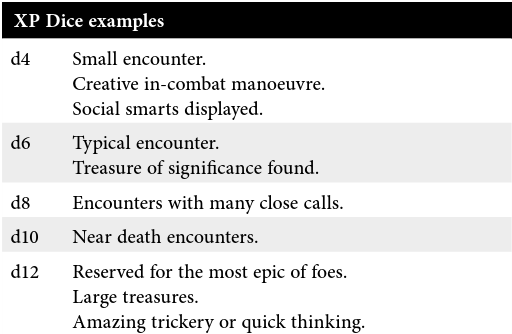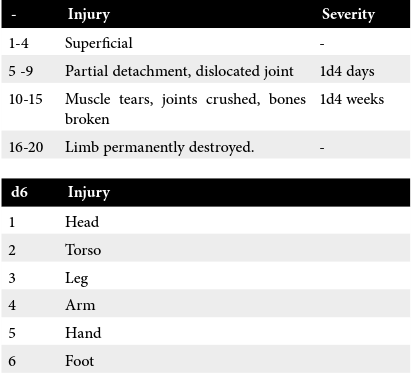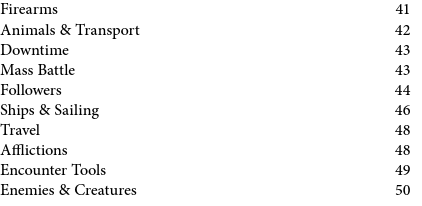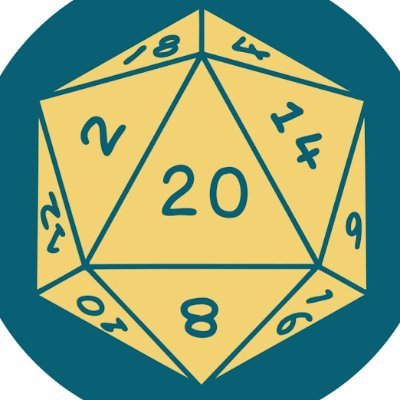


Overview
An indie Fantasy RPG toolkit with some neat ideas for magic and character creation. Focuses on perilous adventures
- Deadly
- You don't have alot of health and there is a mechanic built in for fighting into the negatives
- Clever
- There are a lot of small fun mechanics to play with here. Particularly the magic dice
- Tactical
- Every attack is a choice. There are 4 different attack types, and which you choose matters

Resolution Mechanic
The resolution system is a roll over d20 system where you meet or beat specific DCs. To simplify the process the DCs are set to Easy (8), Normal (12), and Hard (16). There is a suggestion for the GM to ask the players to make the check of a 4 for extremely easy or 20 for very hard scenarios.
These DCs are also considered thresholds. If someone is making a Hard check (16), and fail, but rolled a 13, they still succeeded at what would be normal. The GM can judge the check based on what threshold it did complete leading to potential partial successes.
A secondary mechanic the GM can utilize is a Fate Die roll. This is letting 1d6 determine the result.
- 4-6 = yes
- 1-3 = no
Character Design
Ancestry/Race/Kin
Eleven Gnomish Highlander Meadowfolk RiverfolkAge
There are 3 ages in the game: youthful, mature, and elder. Each of these will give some sort of bonus to your attributes or grant you an additional skill die.
It is also noted in here that to determine your Appearance you will roll 2d6 - 6. This could be a variant to the method listed previously.
Bloodline
Your bloodline will also grant you some sort of feature. These features could be very specific skills being good, some form of metacurrency with a use case, or different attributes being improved from the start.
- Meadowfolk get to roll 2d4 and choose which is their positive and negative die for attribute selection
- Riverfolk get a d6 skill in swimming, climbing etc
- Elves get -2 Fortitude, +1d4 Appearance and +1 Finesse
Attributes
Appearance Finesse Fortitude Willpower WitsThe character attributes in the game are measured from -1 to +5. Besides the listed attributes above the game also includes Armor, and Initiative Dice as key attributes.
To establish your attributes roll 1d4. The result is the amount of points you can now distribute across all of your attributes. You will also roll a second d4 and use that to subtract from any of your attributes in the same manor (but you cannot subtract from Appearance). Finally you will roll (1d10 - 5) and add this to your Appearance to have your final attribute results.
- Roll a 3 and decide that I want +1 Fortitude and +2 Finesse
- Roll a 2 and subtract 1 from Wits and Willpower
- Roll a 9 (-5) and have a +4 Appearance.
Skills
Starting players will select 3 skills from the above list, or work with their GM to create a skill not listed here. Having a skill in something is represented by a Bonus Die that you roll with your normal Checks. These bonus die range from d4-d12.
Starting out your 3 skills are all d4s. To improve a skill you must use it. Each time you use a skill within a 24 hour period you get to fill in a progress bubble next to the skill. When all the progress bubbles are filled you will then turn these in and increase the skill's die size.
Background
Past Soul
There is a d20 table that results in an Archetype. This is a representation of your soul. It provides a special features, and also a Virtue & Vice that you can lean into. For instance The Hermit is able to "find a path, or escape from a situation" and has the virtue Balanced, and the vice Hesitant. Each of the 20, illustrated by the cards in the image, have a detailed description like this.
Background
There is a background table that requires you to roll 1d20+1d10 giving you 2-30 results. These different backgrounds will also alter your attributes and improve a particular skill.
- Royal Guard gets +1 Fortitude and Vigilance d4 to start.
Interpersonal Connections
There is also a madlibs style peresonal connection table that allows you to flush out more of your characters relationships. You roll 1d20 and each result has a different style madlib to fill out. When filling in the blanks for the madlibs you utilize another player in the party, particularly the one sitting to your right.
- Family Feud - You family has been feuding with ----'s family for generations.
Class / Profession
Alchemist Barbarian Entertainer Hunter Magician Master of Arms Moon Witch Scoundrel Sun PriestEach class fits nicely on 1 page. There is an image of the class with your class hit die value as well as their initiative die value. Then there is a particular feature followed by a list of abilities. All class abilities seem to be ironed out to equal, meaning that as you level you choose from the list opposed to going in a particular order.
Abilities/Power/Feats
Each class has a particular Feature and then a list of Abilities. The features seem to be quite strong and specific to those play styles.
- Barbarian - Constant Rage - whenever you take damage you then can use that number on your next turn to add to Fortitude checks, attack rolls, or damage. Its a resource that can be divided amongst those.
- Scoundrel - Gamble - choose instead of rolling a check to flip a coin. If you are correct you succeed and maintain this ability, if you lose then the ability is gone until your next rest.
Abilities are also quite powerful and flavorful.
- Sun Priest - Word of Valour - anything you say that is in fact true will be believed as truth
- Magician - Bloodline Fuel - gain exploding dice for your spells, but each exploded die deals you 2 damage also.
Equipment / Gear
Gear is represented by Inventory Slots on your character sheet. Depending on which slot you use represents how available the item is to you. Its important to note that everything counts as gear. Your armor, weapon, etc. Some items are group-able, and will count as 1 total item.
The first 5 slots are considered on-hand. These are hooked on belts or ready to be used. The next 5 slots are considered on-person. Only a view seconds to get to. The final area is considered stashed away and are much more difficult to get to quickly.
There is an additional section for small items. These are tiny things that are easily accessible also.
Advancement
Experience is gained through significant actions and is rewarded by the GM. This XP is represented by dice. Different activities or actions that occurred can be represented by different XP dice.
To level up, players will need 10x the level they are trying to reach in XP. Achieving 2nd level requires 20 XP. After players have accumulated XP die they will have the chance to then roll those die and cash them in for the amount of XP that they roll.
Upon leveling players receive a new class ability, and a point that they can use to increase a Skill die, increase an attribute (not appearance), or gain a new d4 Skill.
Players will also increase their total Vigour. They roll their current hit dice total (1 per level) and see if the sum is higher than their current vigour maximum. If it is then they have a new total.
Combat
Initiative
Side BasedSemi-side based initiative. Players will either go before or after all enemies. The enemies will have a initiative die roll, and the players are trying to meet or beat it. Those who succeed go before the enemies. Those who fail go after the enemies.
Players can determine their order amongst themselves within the two groups that are established; before enemies and after.
Players can opt to delay their turn, in which case they would now go after the enemies.
Turns / Rounds
A turn is a single set of actions. Each player gets 1 turn in a round. When the round is complete then all turns refresh and the initiative order is maintained.
Action Economy
Each player is allowed to do the following on their turn
- Move up to a measurement in distance
- take 1 major action
- perform some minor task or environmental interaction.
As a party they also have 1 Heroic Reaction that can be spent. Each turn they can choose 1 player to use it, which grants them an additional action. This is typically done in response to the GM doing something. The drawback is that whoever does a Heroic Reaction must spend their next turn only using movement.
Attack Mechanic
When attacking a player must first determine what attack style they are utilizing. Each attack style has its benefits.
- Tactical = add skill die to the hit roll or damage roll
- Defensive = add skill die to any defensive check
- All-in = gain another free skill die to add to either damage or hit (no defense during turn)
- Multi-attack = Skill dice as an additional damage to a different target (cleave)
Attacks are made the following way. Roll 1d20 + Fort or Finesse. Then depending on the type of attack use a skill die from one of your Weaponry Skills. To apply damage you then roll the specific weapons damage die adding bonuses from the attack style you used.
Creative Attacks
Sometimes players describe or come up with fantastic ideas. In these cases they can use their Wits modifier for hit instead of Fort or Finesse. These fantastic ideas are not just descriptive, but potentially very tactical. So its not just swinging from a chandelier, but maybe going for a weak point on the enemy.
Defensive Mechanic
Enemies don't attack, but instead players need to Brace or Dodge an enemy.
- Bracing = roll d20 + fort + armor. Success reduces damage by your fort + armor score. Failure means you only reduce it by the fort
- Dodging = roll d20 + finesse + armor. Success no damage, failure takes all damage
Each of these also have Critical success and critical fail results.
Modifications to Resolution
Most of the game utilizes the Bonus Die mechanic. You utilize skill die in multiple ways to add their results to your d20 rolls.
Environment
There are specific rules for the environment in terms of moving; climbing, mud, unstable ground, sprinting.
Distances
A defined measurement is 30ft, but on the table this is 6in roughly.
- Touch = within 1/2 in
- Measurement = 6 inches
- Close = Anything visible
- Far = shouting distance
Resource Management
Rest Mechanic
There are two mechanics for this, a rest and a recover. A rest is a full nights sleep. You make a Fortitude check hoping to exceed your vigour. If you do you regain an amount of Vigour equal to 1 vigour die + level. A recover results all vigour, magic dice, or other resources. It costs money because you are having to stay at a plush establishment and be pampered in essence.
Resource
Vigour is your hit point total. You will be trying to keep this out of the negatives. Magic Dice are your spell casting fuel. These will lock and unlock depending on rest.
Health & Dying
Your health is equal to your Vigour. You use your defense to try and not go into the negatives. There are ways to be healed by your allies, but you can also gain health through adrenaline. Whenever you kill an enemy you will gain health equal to the level of the creature. This seems really great for frontline individuals, and is probably the reason that health is relatively low in the game.
When you drop into negative you will suffer some sort of injury as well as begin bleeding out. Bleeding out is interesting because you are still up and moving. If you ever reach -20 you are officially dead. However, while you are in the negatives bleeding out you have a penalty to all checks equal to the negative number you are at.
- You are still fighting at -4 vigour, you have -4 to all checks (attacks, skills, defenses).
There is a Final Stand mecahnic where you can use that negative vigour as a one time bonus, but it will result in more damage to you.
Magic System
The spell system in Brimstone is leveless. However, the number of Magic Dice that your character has and are willing to spend on a spell can determine its potency.
Some spells require checks to be made, others don't. Regardless you will be rolling a number of Magic Dice of your choosing. If you are required to make a check you roll 1d20+ attribute specified by spell + your die results. This determines if it was successful. The Die results and number of die will then determine things like damage, duration, distance, etc.
Its a neat system with quick references. The spells have keywords like Dice, Total, Highest, Lowest. That lets you know if you are totally dice for the damage, taking a specific die, or just using the number of total dice as a numerical value. This really makes you want to spend dice.
Dice also lock if they roll a 4-6. This is similar to spell slots. Its the mitigation of not allowing you to spam dice continuously, but it also makes you feel good when you roll a 1-3. The spell isn't as powerful, but you are able to maintain your total dice and keep going.
GM Guide
There are a lot of other fun mechanics that are offered to the GM for helping them run there game. The image here shows a section in the Contents that lists out some of those rules. In addition to this there is a large section on oaths to deities, motivations for players, etc.
Character Sheet
